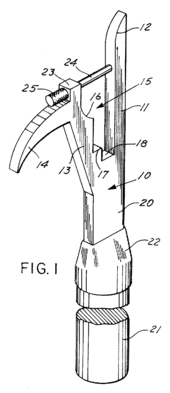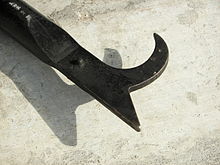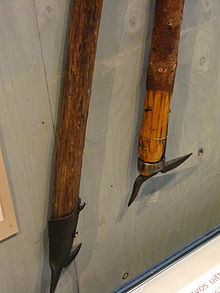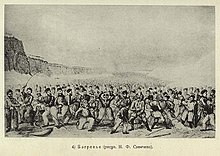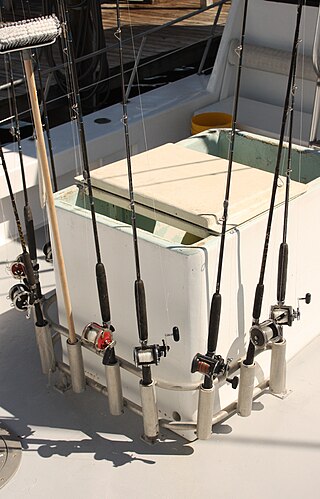
A fishing rod is a long, thin rod used by anglers to catch fish by manipulating a line ending in a hook. At its most basic form, a fishing rod is a straight rigid stick/pole with a line attached to one end ; however, modern rods are usually elastic and generally have the line stored in a reel mounted at the rod handle, which is hand-cranked and controls the line retrieval, as well as numerous line-restricting rings that distribute bending stress along the rod and help dampening down/prevent line whipping and entanglement. To better entice fish, baits or lures are dressed onto the one or more hooks attached to the line, and a bite indicator is used, some of which might be incorporated as part of the rod itself.

The Ural, known before 1775 as the Yaik, is a river flowing through Russia and Kazakhstan in the continental border between Europe and Asia. It originates in the southern Ural Mountains and discharges into the Caspian Sea. At 2,428 kilometres (1,509 mi), it is the third-longest river in Europe after the Volga and the Danube, and the 18th-longest river in Asia. The Ural is conventionally considered part of the boundary between the continents of Europe and Asia.

Ice fishing is the practice of catching fish with lines and fish hooks or spears through an opening in the ice on a frozen body of water. Ice fishers may fish in the open or in heated enclosures, some with bunks and amenities.

Esox is a genus of freshwater fish commonly known as pike or pickerel. It is the type genus of the family Esocidae. The type species of the genus is Esox lucius, the northern pike.

Klarälven is a river flowing through Norway and Sweden. Together with Göta älv, which it is called as the river has passed through the lake Vänern, thus regarded as an entity, Göta älv—Klarälven is the longest river in Scandinavia and in the Nordic countries and its Swedish part the longest river of Sweden. These two rivers also have the largest drainage basin in the same areas, 50,229 km2 (19,394 sq mi) including all the rivers that run into Vänern, of which 42,468 km2 (16,397 sq mi) is located in Sweden and 7,761 km2 (2,997 sq mi) in Norway.
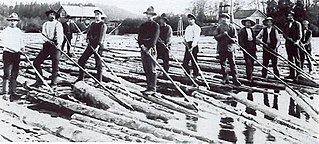
Log driving is a means of moving logs from a forest to sawmills and pulp mills downstream using the current of a river. It was the main transportation method of the early logging industry in Europe and North America.
This is a glossary of firefighting equipment.

In fishing, a gaff is a handheld pole with a sharp hook or sideway spike on the distal end, which is used to swing and stab into the body of a large fish like a pickaxe and then pull the fish out of the water like using a pike pole. Fishing activities that are solely done with gaffs are known as gaffing.

A cant hook or pike or a hooked pike is a traditional logging tool consisting of a wooden lever handle with a movable metal hook called a dog at one end, used for handling and turning logs and cants, especially in sawmills. A cant dog has a blunt end, or possibly small teeth for friction.

Fishing tackle is the equipment used by anglers when fishing. Almost any equipment or gear used in fishing can be called fishing tackle, examples being hooks, lines, baits/lures, rods, reels, floats, sinkers/feeders, nets, spears, gaffs and traps, as well as wires, snaps, beads, spoons, blades, spinners, clevises and tools that make it easy to tie knots.

Coarse fishing is a phrase commonly used in Britain and Ireland. It refers to the angling for rough fish, which are fish species considered undesirable as food or game fish. Freshwater game fish are all salmonids, particularly salmon, trout and char. Generally, coarse fish are freshwater fish that are not salmonids, though there is often disagreement over whether grayling should be classified as a game fish or a coarse fish.
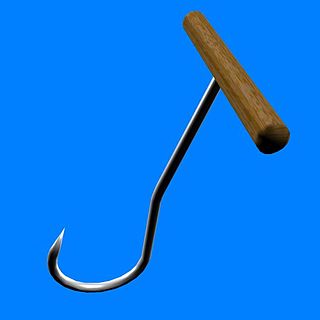
A hook is a hand tool used for securing and moving loads. It consists of a round wooden handle with a strong metal hook about 20 cm long projecting at a right angle from the center of the handle. The appliance is held in a closed fist with the hook projecting between two fingers.

Fishing techniques are methods for catching fish. The term may also be applied to methods for catching other aquatic animals such as molluscs and edible marine invertebrates.
A polespear is an underwater tool used in spearfishing, consisting of a pole, a spear tip, and a rubber loop. Polespears are often mistakenly called Hawaiian slings, but the tools differ. A Hawaiian sling is akin to a slingshot or an underwater bow and arrow, since the spear and the propelling device are separate, while a polespear has the sling attached to the spear.

Traditionally, many different kinds of boats have been used as fishing boats to catch fish in the sea, or on a lake or river. Even today, many traditional fishing boats are still in use. According to the United Nations Food and Agriculture Organization (FAO), at the end of 2004, the world fishing fleet consisted of about 4 million vessels, of which 2.7 million were undecked (open) boats. While nearly all decked vessels were mechanised, only one-third of the undecked fishing boats were powered, usually with outboard engines. The remaining 1.8 million boats were traditional craft of various types, operated by sail and oars.
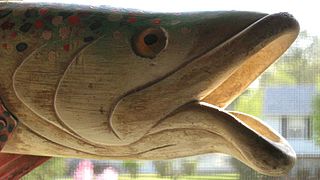
A fish decoy is an object in the shape of a fish or some other animal that is used as a decoy to attract fish. It is often used during ice fishing. Unlike a fishing lure, a fish decoy doesn't have a hook.

Fishing gear and methods used in Uganda are both modern and traditional. Fish in Uganda are caught mostly with plank canoes and to a lesser extent, fiberglass boats. Some dugout canoes are also still being used. The plank canoes are generally 4–12 m (13.12–39.37 ft) in length and dugout canoes average 3.5 m (11.48 ft). The total number of vessels is about 17,000 and about 20% of these are motorized. Artisanal fishermen use various gear including gillnets, seines and hook and line. In a number of localities, traditional methods including baskets, traps and mosquito nets continue to be used. The gear commonly used includes gillnets, lift nets, scoop-nets used in light fishing; hook and line gear and fish traps.
The New York roof hook is a firefighting tool used mostly for rooftop operations including vertical and horizontal ventilation, pulling and prying.

The Caviar of Kladovo was a type of caviar produced in eastern Serbia. It was named after the town of Kladovo, in central Serbia, part of the Danube's Iron Gates Gorge between Serbia and Romania. Made from various fishes' roe, the caviar was granted the protected geographic designation and was considered an expensive delicacy, which was even served on the RMS Titanic. With the construction of large dams in 1972 and 1984, jointly by the two states, the fish migrating from the Black Sea upstream the Danube were prevented from reaching their old spawning areas, and production of caviar was discontinued in the 21st century.
